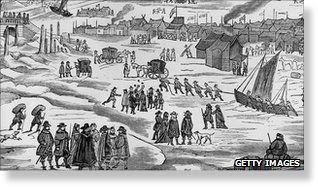
© Getty Images
Scientific speculation is intensifying that a new mini Ice Age is looming.
The last mini Ice Age struck the northern hemisphere about A.D. 1450 and lasted 400 years. It was dubbed the "Little Ice Age." In Canada, it had a huge impact on everything from crop yields to changing ecosystems.
"The Little Ice Age decreased the number of frost-free days and altered the composition of forests," report York University geographers Celina and Ian Campbell.
It was brought on by a seemingly minuscule average cooling of one to two degrees Celsius, climatologists report. But its impact was huge. Historians called it the "General Crisis" owing to its enormous impact: Crop harvests declined "disastrously."
Recent meteorological and other developments have prompted some researchers to predict another mini Ice Age is likely starting to take shape.
According to Habibulla Abdusamatov, an astrophysicist with the Russian Academy of Science, the northern hemisphere has been cooling since the 1990s and 2014 sets the stage for a full mini Ice Age by 2055.
According to the National Oceanic Centre, the North Atlantic is cooling rapidly because the northward circulation of warm, subtropical waters has declined sharply, impacting on the Atlantic Ocean circulation system.
Rutgers University Global Snow Laboratory reports northern hemisphere snow cover has been increasing significantly since 1998; it reached 46.81 million square kilometres in 2014. According to NASA, the solar cycle, which will peak in 2022, is among the weakest in centuries and will enhance cooling.
In North America, the National Climate Data Center has reported December 2013 to March 2014 were the coldest four consecutive months ever recorded in most of central and eastern North America. Ice cover on the Great Lakes was the second-most extensive ever recorded and the Great Lakes Environmental Research Laboratory says ice cover in early April "obliterates all previous records" at 700 per cent above normal.
Little Ice Ages are not as imposing as full-blown Ice Ages.
"Ice Ages occur with some regularity with a relatively short interglacial period (in between)," explained Gerald March, a researcher at the Argonne National Laboratory. "There were few Ice Ages until about 2.75 million years ago... (and most) lasted about 100,000 years."
He added before the Ice Ages, the Earth was warmer than at present. He explained most interglacials last about 10,000 years, the age of the current one.
At its peak, the most recent glaciation (Wisconsin glaciation) covered most of Canada and Europe with ice thousands of metres thick. Temperatures as the glaciation tapered off were five to six degrees Celsius cooler than at present.
Climate has been a huge variable in Canada over time. Some 100,000 years ago, things were cooler than now, and 40,000 years ago, much cooler. From 18,000 to 15,000 years ago, the Wisconsin glaciation was in full force.
Starting about 8,000 years ago, warming intensified and the climate was about 2 C warmer than now. But another bout of cooling started about 4,000 years ago.
According to the Museum of Ontario Archaeology, recent cooler periods produced tundra-like spruce woodlands as far south as southern Ontario, where caribou roamed.
Of course, the brutal winter of 2013-14 might have been an anomaly. But, the National Oceanic and Atmospheric Administration cautions atmospheric conditions that spawned that miserable winter in much of North America will likely be in place again next winter. Another bout of polar vortices anyone?
without Arctic sea ice?
[Link]